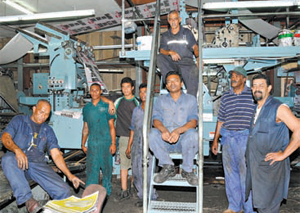
SYDNEY (The PANPA Bulletin/Pacific Media Watch): Computer-to-plate technology is about to hit Fiji. Tabloid daily the Fiji Sun will become the first newspaper in the country to move to the technology, deploying a new Fuji semi-auto system next month to replace its imagesetter equipment.
The investment is a result of strong business growth at the newspaper publisher over the past two years.
“It’s no secret that the 126-yearold Fiji Times, when run by News Limited, was the dominant player in the market,” says Fiji Sun publisher, Peter Lomas. “We have changed that in the past two years.
“We now dominate market share and produce the biggest newspapers, not just in Fiji but in the South Pacific. It’s a nice place to be.
“We have had to rapidly expand our print centre because of our growth.”
One of the reasons for choosing Fuji’s CtP offering, including Fuji PRO-V plates, is its popularity with nearby commercial printers.
“Fuji is proven in the local market,” Lomas said. “We have been able to establish a mutual support agreement with one commercial printer that has an identical set up.”
The print centre was established at the same time as the Fiji Sun in 1999.
Size doubled
The Webco team based in Tauranga in New Zealand initially installed five units of a Goss Community press. It has almost doubled in size since then.
Increasing demand is now forcing Lomas and his colleagues to plan to move the print centre from its original location in Walu Bay, Suva.
Right now, though, Webco staff are upgrading a Eurotherm digital dual drive and two 100hp motors, to make sure the press can run the Fiji Sun’s weekend papers smoothly. Those editions can be as many as 188 pages.
Lomas said: “We are planning to move the press centre into an adjacent building, which has plenty of height and will allow us to put in a four-high tower.”
The Goss Community has been expanded since the early days to nine units, three of which handle colour, plus an SE folder. Lomas said an additional UoP (universal offset press, or tri-colour unit) and extra stack were installed earlier this year in an effort to keep pace with new business and increasing book sizes.
The print team – eight press hands, as well as three each in the management, pre-press and plateroom teams – have plenty keeping them busy. Their focus is “newspapers, newspapers, newspapers”, Lomas says enthusiastically.
There is almost no commercial work, except for a Mandarin newspaper for the local Chinese community. Demand for newspaper-inserted magazines and wraparounds on the seven-day-week Fiji Sun and its sister publications seems insatiable.
Tourist edition
Each day, the company publishes a tourist edition, called the Bula Sun (bula, meaning hello in Fijian), which is distributed to hotels, resorts, and placed on tourism flights and cruise boats.
“When you get up in the morning in a major Fiji resort, we’ll be there to tell you over breakfast what Julia Gillard’s up to, or what’s happening in the AFL,” continued Lomas.
Some of the weekly inserts include Garam Masala – a Bollywood liftout that is popular not just with the Hindi population but many Taukei, or indigenous Fijians, too.
A similar special, called Showtime, is produced separately to cover the gossip and big releases out of Hollywood.
A tourism and lifestyle supplement is printed on 52gsm newsprint, and trimmed and stitched internally.
Some of the most popular inserts focus on sport – a passion of the nation. The plant prints Fiji Football News and Fiji Rugby News.
The portfolio is rounded out by a Fijian-language weekly Na Siga Vou, a fortnightly government newspaper Fiji Focus (which is inserted in the Fiji Sun) and the quarterly University
of the South Pacific journalism newspaper Wansolwara.
Lomas said: “Newspaper growth is still strong in this part of the world. It will be for years to come.”
(cc) Creative Commons



